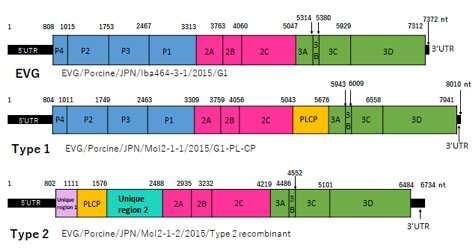Researchers uncover novel virus type that may shed light on viral evolution

Viruses are nonliving creatures consisting of genetic material encased in a protein coat. Once the virus infects a living organism, it can replicate itself and continue on. But what happens if a virus lacks the proper tools to infect an organism? How can it propagate?
An international collaboration led by scientists at Tokyo University of Agriculture and Technology (TUAT) in Japan has uncovered a novel virus that may help answer those questions. They published their results online, ahead of print, on July 22 in Infection, Genetics and Evolution.
Viruses constantly change, combining and recombining into different varieties of themselves. They gain and lose function and either die out or become stronger than ever. This process occurs especially quickly on pig farms, where many pigs interact in filthy environments—it's the ideal setting for viruses to evolve. The team, led by Professor Tetsuya Mizutani, corresponding author on the paper and Director at the Research and Education Center for Prevention of Global Infectious Disease of Animal, TUAT, discovered a unique virus in such a location.
"Recombination among different viral families occurs at pig farms all over the world," Mizutani said. "These recombinant viruses have the potential to connect with a host in a novel way."
It is known that normal enterovirus G (EV-G) presents as diarrhea in pigs. In this study, the researchers found a new type 2 of EV-G in the pigs' feces. They also found that this new EV-G type 2 can't possibly invade a host cell on its own.
"The recombinant virus we found in this study has no structural proteins," Mizutani said. "This means the recombinant virus cannot make a viral particle."
Viruses must make a viral particle to invade a living host cell. Without it, they cannot enter a host cell and use its facilities to replicate itself. According to Mizutani, this particular virus may be partnering up with a "helper virus" to gain access to a host cell, but the mechanism underlying this process is unclear.
"We may be facing an entirely new system of viral evolution," Mizutani said. "We are wondering how this new virus came to be, how it infects cells or how it develops a viral particle. Our future work will be on solving this mystery of viral evolution."
More information: Ryo Imai et al, A novel defective recombinant porcine enterovirus G virus carrying a porcine torovirus papain-like cysteine protease gene and a putative anti-apoptosis gene in place of viral structural protein genes, Infection, Genetics and Evolution (2019). DOI: 10.1016/j.meegid.2019.103975
Journal information: Infection, Genetics and Evolution
Provided by Tokyo University of Agriculture and Technology


















